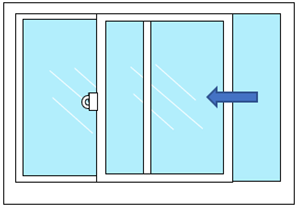By Brandon Bealmear, P.E., FMPC, Fenestrations Practice Leader, Forensic Engineer
Windows are a barrier system infilled within openings in the wall of a building. Inherently, windows are exposed to contrasting environments on the interior from the exterior surfaces. Interior spaces are generally controlled and set to a standard temperature, while exterior environments are ever changing. Air and water travel through the path of least resistance which generally means through openings (windows) of a building envelope. Air filtration through windows can be from static differential pressure or dynamic wind forces. When these pressures become large enough, water can also infiltrate the joints particularly with operable components. Hurricanes combine extreme rainfall and high wind forces, creating the perfect storm that can be very challenging for window performance.
Window and door assemblies are designed to withstand specific wind loads without experiencing structural damage. However, the design pressures for structural integrity can greatly exceed the pressures against which the assemblies are qualified to resist water infiltration, thus leakage can occur through glazing components and weather-stripping without damage occurring to the window assembly. Leaks can also occur around the windows and doors, not necessarily always through the glazing or operable components of the system. Often, leaks around window and door assemblies develop over time through deteriorated flashing components or improperly flashed interfaces, indicative of installation deficiencies. Leaks may only be revealed to the interior during events with a high demand for water tightness such as when water is prevented from draining freely and/or heavy rainfall.


Building codes govern the selection of window assemblies to be used in a building. Both performance and testing parameters are included in all International Residential Codes and International Building Codes adopted nationally since the early 2000s, and some prior to that. Modern day codes specifically indicate that exterior windows and doors shall be capable of resisting the design wind loads specified for the geographical area of the building and be adjusted for height and exposure. Testing and labeling is also included in these codes which requires exterior windows and doors be tested by an approved independent laboratory, and bear a label identifying manufacturer, performance characteristics and approved inspection agency to indicate compliance with American Architectural Manufacturers Association (AAMA 101), Window and Door Manufacturers Association (WDMA I.S.2), and Canadian Standards Association (CSA A440); AAMA/WDMA/CSA 101/I.S.2/A440 (commonly referred to as AAMA 101).

AAMA 101 provides guidance for rating windows and doors, which are described as performance grades (PG) and are based on the design wind pressure determined from the basic wind speed adjusted for height and exposure. Buildings in hurricane prone areas are commonly required to resist pressures induced by wind blowing more than 120 miles per hour, which translates to 40 or more pounds per square feet (PSF) or a PG40 rated window or greater.
Windows tested in accordance with AAMA 101 are required to pass a water penetration test using simulated rain and air pressure differential at 15 percent of the PG. Architectural type windows require 20 percent. Additionally, windows tested in accordance with AAMA 101 are required to pass a structural test with simulated air pressure at 150 percent of the PG. This means there shall be no permanent damage to glass, framing, fasteners, hardware, or other components of the window.
Major hurricanes are defined by the National Hurricane Center and National Oceanic and Atmospheric Administration to be a category 3 or higher on the Saffir-Simpson Hurricane Wind Scale. Sustained winds need to reach 74 miles per hour to be categorized as a hurricane, and 111 miles per hour to be considered a category 3 major hurricane.
During a hurricane, windows are often exposed to winds that approach (or exceed) their design pressures, but it is critical to know that most windows are designed to withstand 150 percent of their ratings before experiencing any structural or physical damage to their components. Alternatively, windows are only designed to resist water penetration at 15 percent of their ratings which is commonly exceeded during hurricane categorized storms. If a window leaks during a hurricane, that doesn’t inherently also mean the system has structural damage or has been compromised by the storm. Windows can leak through joints within their system from wind-driven rainfall and not have components permanently damaged or compromise the window.
The progression of damage helps to determine the extent of damage (if any) a window has experienced from hurricane winds. Moisture ingress through windows often occurs first, followed by impact damage from windborne debris, then structural damage begins to occur from direct forces from the wind. It is commonly misunderstood that if windows leak, they are also compromised. In reality, windows can leak without compromising their ongoing performance values or have a permanent impact on the system.
Author

Brandon Bealmear, P.E., Fenestrations Practice Leader, Forensic Engineer
Brandon D. Bealmear, P.E., FMPC, is the Fenestrations Practice Leader and a Forensic Engineering with Haag Engineering Co. Mr. Bealmear is an AAMA Certified Fenestration Master with 17 years’ experience with glass, wood, aluminum, concrete, masonry, and other construction materials. He has designed, consulted, and written quality control and forensic testing protocols for building envelopes, including fenestration systems and wall systems. His design experience includes performance consulting, mock-up evaluation and testing, construction quality control and defect evaluation, and special controlled inspections. Mr. Bealmear has also provided forensic analysis for residential and commercial properties. His experience includes material failure to structural collapse, construction defects, damage assessments from hail, wind (including tornadoes and hurricanes), earthquake, snow loading, and moisture intrusion. Brandon Bealmear– Fenestration Expert Flyer
Any opinions expressed herein are those of the author(s) and do not necessarily reflect those of Haag Technical Services, Haag Engineering Co., Haag Education, or parent company, Haag Global, Inc.

